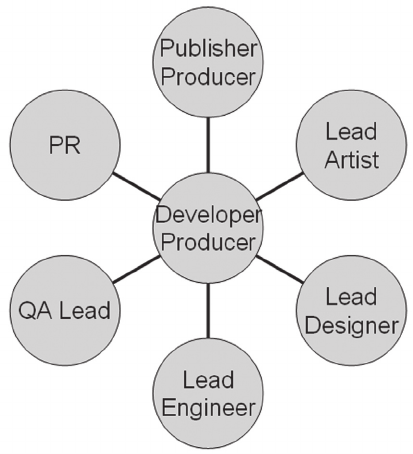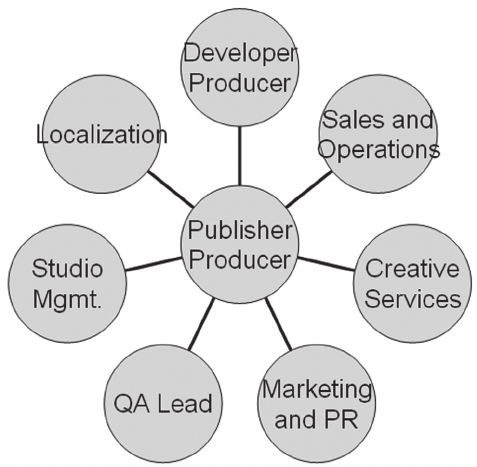
ROLES ON THE TEAM
In This Chapter
• Production
• Art
• Engineering
• Design
• Quality Assurance Testing
• Team Organization
• Corporate
2.1 I
NTRODUCTION
T
o better understand the production cycle, it is important to know what
types of roles are normally found on a game development team. The roles
vary from team to team, depending on the project needs, the company
size, and the scope of a project. For example, if working on a mobile phone
game, the team might be four people who all fulfill multiple roles on the project.
If working on a next-generation console game, the team might have more than
80 people, with each person assigned a specific role on the project.
This chapter discusses the general roles comprising a development team
and how the teams are organized. In addition, information is presented on non-
production roles, such as sales and marketing. For more in-depth information on
roles and job descriptions, please refer to Get in the Game! by Marc Mencher,
published by New Riders.
Chapter 2Chapter 2

18 THE GAME PRODUCTION HANDBOOK, 2/E
WORKING IN GAME DEVELOPMENT
Wade Tinney and Coray Seifert
Large Animal Games
If you are working in game production, you need to have a deep understanding
of games and why people play them. It’s amazing to us how many people, who don’t
play games, apply for jobs at a game company. Would you apply for a job at a film
studio if you didn’t watch movies on a regular basis? One must not only play games,
but also think critically about them. If you don’t understand interactivity and how a
given set of choices affects a player’s game experience, it’s unlikely that you’ll be
able to effectively contribute to the development team. This ability to think critically
about gameplay is especially important for producers and designers.
Aspiring game developers must also be able to interact constructively with other
members of a creative team. Gone are the days when a commercial game could
be created by a single person. It is now imperative for developers to understand
the importance of teamwork in creating a successful product. Even team experience
from other creative industries is a good start; if you have experience working collab-
oratively on a film project, for example, or even on a school project, that experience
can help prepare you for the game industry.
In addition, you must have the discipline to complete your tasks within tight
deadlines, without handholding, and in many cases, with fewer resources than you
would really like. Frequently, smaller development teams depend on each member
to wear many different hats and to do whatever it takes to get the game done. This
can include designing parts of the game, making decisions on budgets and sched-
ules, or even creating art assets. If you are able to quickly adapt to situations like
these, you will be right at home making games.
2.2 PRODUCTION
Production roles run the gamut from production coordinator to executive pro-
ducer. People involved in game production are focused on managing and tracking
the game’s development and are the main intermediary between the develop-
ment team and anyone external to the team, even studio management. Those in
production roles should keep the team happy, motivated, and productive on the
project. Production people are not usually responsible for actually creating game
assets, as their main responsibility is to efficiently manage the people creating
the content. This management keeps the team’s time focused on actually com-
pleting game tasks instead of tracking schedules, dealing with personnel issues,
ROLES ON THE TEAM 19
managing external vendors, negotiating contracts, proofreading marketing copy,
and anything else external to creating game content.
Three basic production roles exist, although the names may vary from com-
pany to company:
■
Executive Producer
■
Producer
■
Associate Producer
Not all of these roles are necessary for every project, which means that the
responsibilities shift for each role, depending on the needs of the project.
Executive Producer
An executive producer (EP) is usually a producer with five to 10 years of produc-
tion experience. EPs most often oversee multiple projects, and their main func-
tion is to ensure that all the games in development are running smoothly and
efficiently. They are focused on broader production tasks—researching hard-
ware and middleware needs, establishing employee training programs, negoti-
ating contracts, evaluating external vendors, and other things that will benefit
current and future projects.
An EP normally reports to the studio vice president or chief executive officer
(CEO). He or she manages multiple producers and works with the producers
individually to evaluate and implement solutions for potential problems on the
projects. They are not involved with the day-to-day operations of the develop-
ment team and do not communicate with the project leads on a regular basis, as
that is the producer’s responsibility.
Producer
The producer is typically a developer with three to five years of production ex-
perience and who has worked as an associate producer on several titles. The pro-
ducer is usually in charge of a single game and the entire development team for
that game. The producer is one of the most visible people on the project and is
the team’s representative to anyone outside the team. His or her primary respon-
sibility is to make sure that the game is delivered on time, on budget, with all the
expected features, at the highest quality possible, while keeping the team focused
on and enthusiastic about their work. Although a producer is heavily involved with
the project leads in making creative decisions, the main focus is on facilitating the
development process, not on dictating the creative content and game features.
The producer reports to an executive producer or studio vice president and
works closely with marketing, sales, operations, public relations (PR), studio
management, creative services, legal, third-party console manufacturers, and

20 THE GAME PRODUCTION HANDBOOK, 2/E
external vendors. Also, a producer manages the game development plan, com-
municates it to the team, tracks it, and neutralizes any risks to the plan. Basically,
a producer steers the development team toward completion.
Producers can focus on different areas, depending on the needs of their
projects and how their development teams are structured. The most noticeable
division in production roles can be seen when comparing a publisher producer
with a developer producer.
A developer producer (DP) directly manages an internal development team.
He or she works closely with the art, engineering, design, and quality assurance
leads on the project. As a core team, the DP and leads work together to create
the development plan and update it as necessary; the DP also is involved in
the day-to-day production of the game. If working for an external publisher, the
DP will communicate on a regular basis with the publisher producer. Figure 2.1
is a diagram of a DP’s main points of contact.
FIGURE 2.1 Developer producer’s main project contacts.
A publisher producer (PP) represents the publisher’s interests and usually
works with external developers. Rarely do they manage the actual development
team, but instead, oversee other departments who are not directly involved in
the internal game development cycle, such as sales, marketing, quality assur-
ance, and localization. A PP can manage multiple projects, especially if they are
not all scheduled to be released at the same time. Figure 2.2 is a diagram of the
PP’s main points of contact.

ROLES ON THE TEAM 21
FIGURE 2.2 Publisher producer’s main project contacts.
There are several types of producers one may encounter on a project, such
as a creative producer or a project manager. The type of producer depends on
the project, the team size, and the needs of the company.
Associate Producer
An associate producer (AP) typically has one to three years of experience and
may have started out in an entry-level development position, such as a quality
assurance tester or production coordinator. The AP’s primary responsibility is
assisting the producer with any production-related tasks. A more experienced
AP can also be in charge of producing a major aspect of the game, such as local-
ization, music and voiceover, cinematics, or open beta tests.
The associate producer reports directly to the producer and may be one
of several on a project. They interact with the team on a day-to-day basis
and may also be tasked to help the art, design, and engineering leads when
necessary.
Background and Training
Because producers have a variety of backgrounds—some started out in game
development and worked their way up, and others worked in a different industry
..................Content has been hidden....................
You can't read the all page of ebook, please click here login for view all page.
